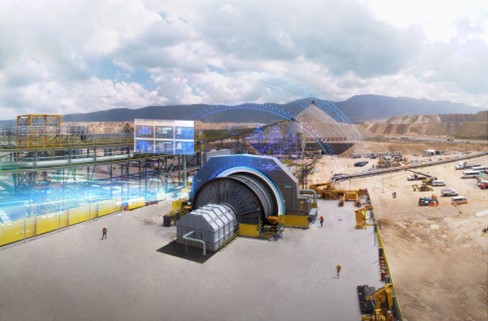Digital Lifecycle Excellence for mining

Our Digital Lifecycle Excellence (DLE) solution for the mining industry blends data management and digitalization from traditional engineering and manufacturing disciplines. It helps mining companies and important participants of the mining value chain to organize and manage complex data and helps them to become more competitive.
In an industry rocked by a global pandemic, strict regulatory requirements, and renewable energy demands, today’s mining companies can use DLE to leverage the value from their physical assets and enterprise data to improve efficiencies, reduce costs, and ensure compliance.
How DLE benefits the mining industry
One of the most obvious benefits of DLE for mining is the fact that capital asset management is made easier. This is especially important for the mining industry since asset management is often a complex activity with multiple entities and related functions involved.
Efficient asset management is also very beneficial for an industry that is concerned with sustainable mining practices. Mines are increasingly moving towards decarbonization to maintain sustainability as well as meet targets. With calls for net zero emissions by 2050, there’s more pressure than for industries across the board to streamline their business practices to adhere to achieve the goal for net zero emissions.
In October 2021, members of the International Council on Mining and Metals (ICMM) committed to a goal of net zero Scope 1 and 2 greenhouse gas (GHG) emissions by 2050. This is also in line with the Paris Climate Change Agreement. The Minerals Council South Africa also fully supports the Paris Agreement. The Council is working on a Net Zero 2050 Action Plan and pathway towards achieving the goal of net zero GHG emissions.
DLE will assist mines in keeping track of their energy consumption as well as utility usage across operations. A DLE approach also makes it possible for physical asset reports to be generated and accessed in real-time – giving companies a clear indication of asset performance and requirements.

Another notable benefit of DLE is related to compliance and risk management. Mining is an industry with inherent risks, some of which are inevitable. As a result, various measures – such as legislation – have been put in place to mitigate identified risks as far as possible. Such measures require compliance.
One of the biggest concerns for mining companies is reducing the risk of non-compliance across an entire enterprise. Already heavily regulated, new calls for net-zero emissions and renewable alternatives have put intense pressure on organizations to develop more efficient processes. South Africa’s mining industry has plans in the pipeline involving renewable energy projects. According to Roger Baxter, Minerals Council CEO, the mining industry is involved in various stages of building plants, conducting studies, planning and applications for up to 3 900MW of renewable solar, wind and battery energy projects which could provide Eskom some of that much-needed supplemental capacity.
How DLE works
DLE works as a digital thread to connect the digital world with physical objects or processes. The tools included in DLE work together to organize and consolidate data and present opportunities to increase competitiveness. This means mining companies can add solutions throughout their product lifecycle without worrying whether they are compatible.
In addition, DLE solutions provide simulation tools that allow mining companies to establish comprehensive, closed-loop digital twins of a plant, facility, or product. These digital twins generate insight that can be used to reach sustainability targets, reduce cost and the risk of non-compliance, and to improve quality and safety.
Digital twins, virtual reality or other simulation software are the best tools for helping mines plan out major projects. Using a simulation-driven approach to design allows businesses to verify plant processes before construction ever begins. Other capabilities include mapping out construction areas to simulate how equipment or systems will operate during the building process and adjusting to optimize the process as needed. Predicting construction execution can reduce the risk of change orders, excessive production costs and overall energy consumption.
Additional solutions for mining companies
Environmental Compliance Management: this enables mining companies to monitor compliance requirements by providing efficient processes for hazardous substance management, supplier disclosures, regulatory reporting, and a sustainability framework.
Production Planning and Scheduling: these tools use advanced algorithms to assist planners to optimize production schedules while considering all possible disruptions and scenarios. This allows equipment OEMs, EPCs or owner-operators to evaluate multiple production scenarios to react quickly to any changes and make appropriate decisions
Low-code Application Development: A low-code platform for fast and efficient application development empowers stakeholders and employees to work together in a collaborative environment to define requirements, process feedback, manage deployment, and monitor applications. Bespoke applications can be developed to utilize existing systems and data and extend the value of current technology investments The mining industry is no stranger to innovative technologies as over the years smart technologies have been deployed by mining companies to increase health and safety, productivity and efficiency. DLE would be another smart solution to assist the mining industry in asset management.


